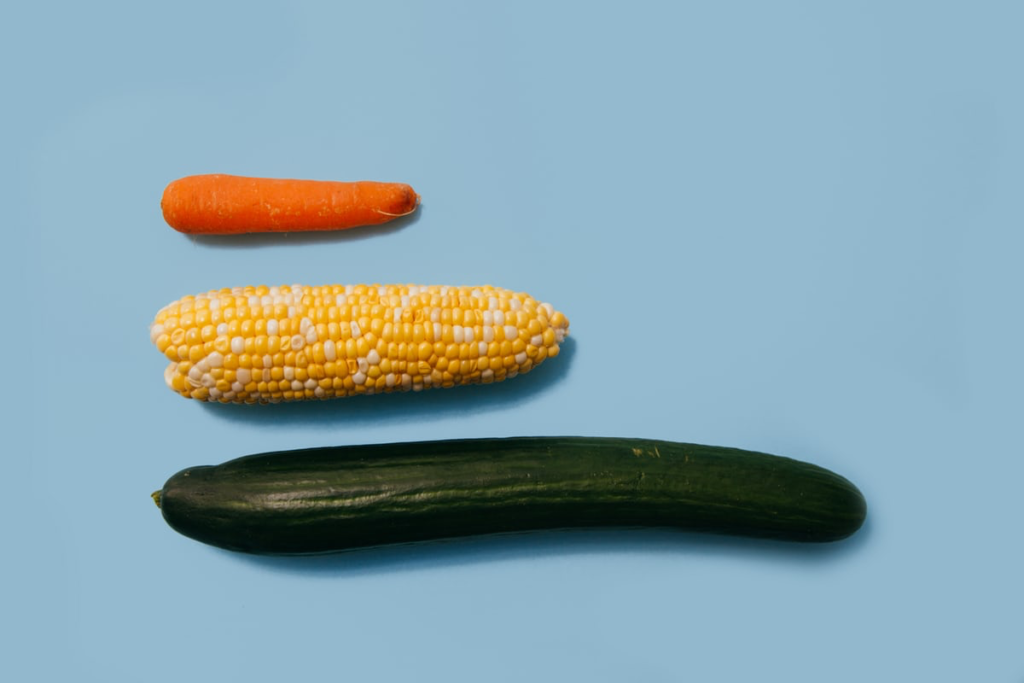
Sex education often extends far beyond the classroom. People learn about sex from word of mouth, friends, family, and the media. This informal sex education process spreads information based on individual experience, local folklore, cultural values, or traditional customs, often resulting in the exchange of unreliable, inconsistent information.
Table of Contents
Popular Myths and Folklore
Sex myths that waver between fact and fiction, so understanding the difference can be crucial in maintaining a healthy sex life. This article will either affirm or “myth bust” popular sex myths with a critical scientific lens. Proper scientific evidence will help to expose or support each sex myth.
Myth #1 – “Big feet or hands equals a big penis”
In Other Words
Is the size of a male’s penis proportional to the size of his hands or feet?
Conclusion

BUSTED: You might have heard someone allude to the size of their penis by referencing their shoe size. “I’m a shoe size 11—you know what that means, right?” Well, according to scientific evidence, that means nothing. In a study published on the National Center for Biotechnology Information, two urologists measured the erect penile length of 104 males and compared it to each male’s shoe size. They found that there was no statistically significant correlation between the two measurements.1
You may have also heard someone reference their hand size as an indication of penile length. In this case, that there is a correlation between hand size and penile length. A study performed on 144 males published on the National Center for Biotechnology Information Journal indicates that although there is no correlation between hand size as a whole and penile length, there is evidence of a slight correlation between finger length and penis length.2 However, this correlation is not statistically significant enough to accurately assume the length of a male’s penis based on their finger length. Researchers acknowledge these results are inconclusive and in no way prove causality between the two variables.
Myth #2 – “Too much sex makes a female’s vagina loose”

In Other Words
Does frequent sex alter the size, shape, and tightness of a female’s vagina?
Conclusion
BUSTED: Many people believe that vaginal tightness decreases as an individual has more sex. Many also believe that a “virgin” vagina is very tight and that sex permanently loosens the vagina, and that frequent sex loosens it even further. This myth is entirely false. The vaginal muscles are very elastic. When lubricated and aroused, the vaginal muscles become relaxed and are capable of stretching open. Once an individual returns to a non-aroused state, the vaginal muscles tighten and contract back to their original state.3 While frequent sex can help to stretch the hymen, which decreases irritation associated with sex, frequent sex does not stretch the vagina.3
Myth #3 – “Sexual pleasure is dependent on the size of a male’s penis”

In Other Words
Does a larger penis cause increased satisfaction for a partner?
Conclusion
Busted: The amount of pleasure a person feels during sex is not necessarily dependent on the size of a male’s penis. In a study published in the BMC Women’s Health Journal, 50 sexually active females who have had two or more partners were interviewed about their sexual preferences. Almost all females reported that penis length did not make any difference in sexual pleasure. Most females felt that width was more important than length to their pleasure.4 Furthermore, the average vagina is only three to five inches in depth, which means that if a penis were any longer, it would not increase satisfaction.5 In fact, the more sensitive areas on a person are located on the exterior of the body (like the frenulum in males and the clitoris in females), or just inches inside (like the G-spot in females or the prostate in males). Most females argue that the technique involved in sexual activity is more important than the size of the penis.4 Proper foreplay and stimulation can increase pleasure for both females and males far more than penis size can. Moreover, sexual pleasure and satisfaction is not solely derived from the physical act of coitus itself. For example, having a strong emotional attachment with the other partner can increase the level of intimacy before, during, and after sex, which can influence how a person feels overall.
Myth #4 – “Laptop computers and cellular devices can lower a male’s sperm count”
In Other Words
Will resting a laptop computer or phone near a male’s testes increase his chances of infertility?
Conclusion

TRUE: Although laptops and other devise can decrease a male’s sperm count by warming up the scrotal temperature, they are not nearly strong enough to cause infertility.6 Sperm production slows and is sometimes impaired at warmer temperatures. The heat generated from laptops and cell phones can temporarily have an impact on sperm count and quality, but one study finds that this does not produce a significant effect on a male’s fertility.6 While researchers claim further studies are needed to validate these conclusions, for now it is best to limit the testicular exposure to laptop computers and phones in general. Prolonged exposure to laptops and phones have not yet been evaluated so it is best to take caution. The most recent scientific evidence establishes that if any damage has occurred, it is only a temporary effect on the male’s ability to rapidly produce sperm.
Myth #5 – “Circumcised penises are less sensitive”
In Other Words
Does a having a circumcised penis decrease sexual satisfaction or sensitivity during sex?
Conclusion

BUSTED: Studies performed on males regarding their relative sexual experiences and levels of pleasure during sex show that there are no overall differences in sexual satisfaction between circumcised and uncircumcised males.7 Although studies do indicate that uncircumcised penises experience a heightened sensitivity, the overall function and satisfaction of individuals with circumcised penises is no different. An Australian study uniformly found, “circumcision had no overall adverse effects on penile sensitivity, sexual arousal, sexual sensation, erectile function, premature ejaculation, ejaculatory latency, orgasm difficulties, sexual satisfaction, pleasure, or pain during penetration.”8 Evidently, circumcision does not affect the functioning or satisfaction of sex in a male.
Myth #6– “There is something wrong if a male can’t last a long time before ejaculating”
In Other Words
Are males supposed to engage in sexual intercourse for extended periods of time before ejaculating?
Conclusion

BUSTED: The average length of coitus ranges from three to six minutes long.9 Pornographic videos are often edited to make the duration of sex seem longer than it actually is. More often than not, what you see in pornography is an extreme misrepresentation of sex and almost always depicts unrealistic versions of reality. Ways to elongate the duration of coitus can be found here.
Myth #7 – “Drinking pineapple juice makes semen taste better”
In Other Words

Will drinking fruit juices (notably pineapple juice) alter the taste of semen to make it sweeter?
Conclusion
BUSTED: There is no scientific evidence that has proven that the consumption of sweet fruit juices alters the taste of semen. Although some partners report that a healthier diet enhances the taste of semen in their partner, this is unfortunately unfounded in any scientific evidence. Experimenting with this holds no risks, and can even help to spice up your sex life.
Myth #8 – “If you are aroused, you should not need lubricant”
In Other Words
Do all females produce enough lubricant, if aroused, for coitus to take place comfortably?
Conclusion

BUSTED: A study performed on 2,453 sexually active females investigated the use of lubricant during sexual activity. Some females found that although they were already aroused, the use of lubricant helped to increase sensation and decrease any discomfort caused by coitus.9 Although some females find that lubricant is unnecessary because they are able to produce a sufficient amount of lubricant, lubricant remains beneficial to others who do not produce enough lubricant on their own. This does not mean that a female is not properly aroused, however. Some individuals have difficulty producing enough vaginal lubricant on their own even when they are sufficiently aroused. Supplementing a body’s natural lubricant with a water or silicone based lubricant does not substitute for a female’s arousal.
Myth #9 – “You can be addicted to masturbation”
In Other Words
Is there a point where too much masturbation is unhealthy?
Conclusion

TRUE: Masturbation is a very healthy activity for males and females. Masturbation is a form of sexual expression and liberation, and is very subjective for each person. An individual’s masturbatory habits are healthy unless these habits intrude on daily life activities.10 If an individual’s masturbation habits interfere with social activities, then this person may be at a point where masturbation is unhealthy and should try to scale back on the amount. For the most part, however, masturbation is a healthy and normal activity.
Myth #10 – “All females can experience orgasm through intercourse”
In Other Words
Can all females orgasm through penetrative coitus, without any other stimulation?
Conclusion
BUSTED: Although some females can orgasm during intercourse, most females are unable to do so.11 Many females are only able to orgasm through clitoral stimulation.12 There are many positions that partners can try out during coitus to increase stimulation to the female’s clitoris. Furthermore, a female can try to locate her G-spot which is about two to three inches inside the vaginal canal. Locating the G-spot can help increase the chances of orgasm through coitus alone. However, not all females are able to locate the G-spot and are therefore unable to orgasm during coitus.
Myth #11 – “You cannot get pregnant if you are on your period”
In Other Words

If you have unprotected sex during the time of a female’s period, can the female become pregnant?
Conclusion
BUSTED: Sperm can live inside an individual for up to five days. Depending on a female’s menstrual cycle, the sperm can stay inside a female following her period and into ovulation. In this case, a female can become pregnant if they have unprotected sex on their period.13
Myth #12 – “Smoking marijuana has a negative impact on semen quality”
In Other Words
Does smoking marijuana lower a male’s sperm count?
Conclusion

True: Many studies on the effects of marijuana on sperm quality generally agree that smoking marijuana on a regular basis has a negative impact on sperm concentration. In one specific study, researchers found that regular marijuana smoking (more than once per week) was associated with a 28% lower sperm count.14 There is no current evidence to suggest that occasional marijuana usage has any lasting effects on sperm count or motility.
Concluding Remarks
Myths about sex have been around for a long time. The unfounded knowledge that is passed along through word of mouth and the media can often mislead people. Understanding the difference between fact and folktale can help individuals maintain a healthy and knowledgeable sex life. Proper scientific evidence can help decipher whether each sex myth is fact or fiction.
References
- Shah, J. Christopher, N. (2002). Can shoe size predict penile length? BJU International: Vol. 90; Pp. 586-87.
- Davarci, Mursel. et. al. (2012). A new anthropometric measurement of penile length and its relation to second and fourth digital lengths. Turkish Journal of Medical Sciences: Vol. 42, No. 3; Pp. 539-44.
- Castleman, Michael. (2011). The Rare Truth About “Tight” and “Loose” Women. Psychology Today. Online.
- Eisenman, Russel. (2001). Penis Size: Survey of female perceptions of sexual satisfaction. BMC Women’s Health. Vol. 1, No. 31.
- Castleman, Michael. (2011). The Rare Truth About “Tight” and “Loose” Women. Psychology Today. Online.
- How Deep is a Vagina? And 10 Other Things You Should Know. (2015). Healthline. Online.
- Karioch, O. M. (2008). Laptops, infertility, and testicular cancer. British Journal of Urology. Vol. 75, No. 1; Pp 113-117.
- Morris, Brian J. Krieger, John N. (2013). Does Male Circumcision Affect Sexual Function, Sensitivity, or Satisfaction?—A Systematic Review. International Society for Sexual Medicine: Vol. 10; Pp. 2644–2657.
- Herbenick, Debra, Michael Reece, Devon Ensel. (2010). Association of Lubricant Use with Women’s Sexual Pleasure, Sexual Satisfaction, and Genital Symptoms: A Prospective Daily Diary Study. The Journal of Sexual Medicine. Vol. 8, No. 1.
- “Masturbation.” Female & Male. N.p., n.d. Web. 27 Feb. 2014.
- “Can You Get Pregnant on Your Period?” American Pregnancy Organization. Web. 2 Sep. 2016.
- Koedt, Anne. (2000) The Myth of the Vaginal Orgasm. Radical Feminism: A Documentary Reader.
- “Do women orgasm during sex?” Planned Parenthood. Web. 15 Aug. 2013.
- Gundersen, Tina D. et. al. (2015). Association Between Use of Marijuana and Male Reproductive Hormones and Semen Quality: A Study Among 1,215 Healthy Young Men. American Journal of Epidemiology: Vol. 182, No. 6.
Last Updated: 19 February 2018.
